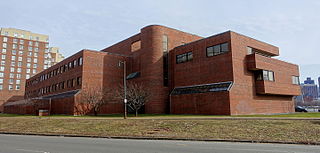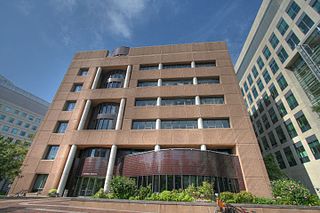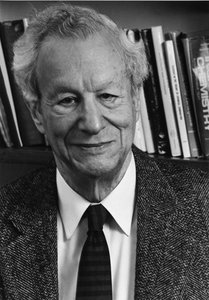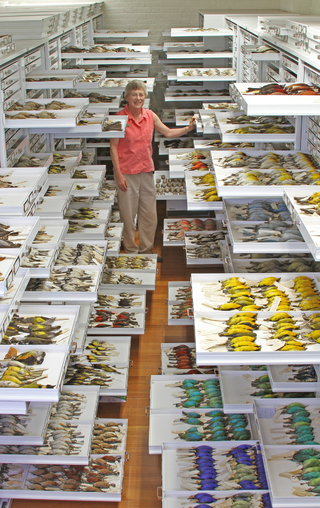Related Research Articles
Metallic hydrogen is a phase of hydrogen in which it behaves like an electrical conductor. This phase was predicted in 1935 on theoretical grounds by Eugene Wigner and Hillard Bell Huntington.

The Rowland Institute at Harvard, formerly the Rowland Institute for Science, was founded by Edwin H. Land as a nonprofit, privately endowed basic research organization in 1980. The institute merged with Harvard University on July 1, 2002. The Rowland Institute is dedicated to experimental science across a wide range of disciplines. Research subjects at the institute includes chemistry, physics and biology, and focus on interdisciplinary work and the development of new experimental tools. It is located on the Charles River near Kendall Square in Cambridge, Massachusetts, and is a few miles away from the main campus of Harvard.

Whitehead Institute for Biomedical Research is a non-profit research institute located in Cambridge, Massachusetts, United States that is dedicated to improving human health through basic biomedical research. It was founded as a fiscally independent entity from the Massachusetts Institute of Technology (MIT), where its 19 members all hold faculty appointments in the MIT Department of Biology or the MIT Department of Bioengineering. As of 2023, Ruth Lehmann is its director; she succeeded David C. Page.

John Clarke Slater was an American physicist who advanced the theory of the electronic structure of atoms, molecules and solids. He also made major contributions to microwave electronics. He received a B.S. in physics from the University of Rochester in 1920 and a Ph.D. in physics from Harvard in 1923, then did post-doctoral work at the universities of Cambridge (briefly) and Copenhagen. On his return to the U.S. he joined the physics department at Harvard.

Edward Charles Pickering was an American astronomer and physicist and the older brother of William Henry Pickering. Along with Carl Vogel, Pickering discovered the first spectroscopic binary stars. He wrote Elements of Physical Manipulations.

The Harvard Graduate School of Education (HGSE) is the education school of Harvard University, a private research university in Cambridge, Massachusetts. Founded in 1920, it was the first school to grant the EdD degree and the first Harvard school to award degrees to women. HGSE enrolls more than 800 students in its one-year master of education (Ed.M.) and three-year doctor of education leadership (Ed.L.D.) programs.

The Berkman Klein Center for Internet & Society is a research center at Harvard University that focuses on the study of cyberspace. Founded at Harvard Law School, the center traditionally focused on internet-related legal issues. On May 15, 2008, the center was elevated to an interfaculty initiative of Harvard University as a whole. It is named after the Berkman family. On July 5, 2016, the center added "Klein" to its name following a gift of $15 million from Michael R. Klein.
The Harvard–MIT Program in Health Sciences and Technology, or HST, is one of the oldest and largest biomedical engineering and physician-scientist training programs in the United States. It was founded in 1970 and is the longest-standing collaboration between Harvard University and the Massachusetts Institute of Technology (MIT). Within the program, graduate and medical students are registered with both MIT and Harvard and may work with faculty and affiliated faculty members from both communities. HST is a part of MIT's Institute for Medical Engineering and Science and forms the London Society at Harvard Medical School.

Frank Henry Westheimer was an American chemist. He taught at the University of Chicago from 1936 to 1954, and at Harvard University from 1953 to 1983, becoming the Morris Loeb Professor of Chemistry in 1960, and Professor Emeritus in 1983. The Westheimer medal was established in his honor in 2002.

Richard Lawrence Garwin is an American physicist, best known as the author of the first hydrogen bomb design.

The Museum of Comparative Zoology is a zoology museum located on the grounds of Harvard University in Cambridge, Massachusetts. It is one of three natural-history research museums at Harvard, whose public face is the Harvard Museum of Natural History. Harvard MCZ's collections consist of some 21 million specimens, of which several thousand are on rotating display at the public museum. In July 2021, Gonzalo Giribet, Alexander Agassiz Professor of Zoology at Harvard and Curator of Invertebrate Zoology, was announced as the new director of the museum.
The MIT School of Science is one of the five schools of the Massachusetts Institute of Technology, located in Cambridge, Massachusetts, United States. The School is composed of 6 academic departments who grant SB, SM, and PhD or ScD degrees; as well as a number of affiliated laboratories and centers. As of 2020, the Dean of Science is Professor Nergis Mavalvala. With approximately 275 faculty members, 1100 graduate students, 700 undergraduate majors, 500 postdocs, and 400 research staff, the School is the second largest at MIT. As of 2019, 12 faculty members and 14 alumni of the School have won Nobel Prizes.

William Duane was an American physicist who conducted research on radioactivity and X-rays and their usage in the treatment of cancer. He developed the Duane-Hunt Law and Duane's hypothesis. He worked with Pierre and Marie Curie in their University of Paris laboratory for six years and developed a method for generating quantities of radon-222 "seeds" from radium for usage in early forms of brachytherapy.
Bruce Howard McCormick (1928–2007) was an American computer scientist, Emeritus Professor at the Department of Computer Science, and founding director of the Brain Networks Lab at Texas A&M University.

Horst Meyer was a Swiss scientist doing research in condensed matter physics.
Lawrence William Jones was an American academic and professor emeritus in the physics department at the University of Michigan. His field of interest was high energy particle physics.
John R. Tucker was an American physicist who made several contributions to the fields of electronics, physics and microwave theory, known for generalizing the microwave mixer theory and presenting the body of work, known as the "Tucker theory", and for his fundamental theoretical contributions which resulted into various advancements in experimental Submillimeter astronomy. He is also credited with laying down some of the technological foundations for making practical Quantum computing possible.
Gary F. Hinshaw is a cosmologist and physics professor at the University of British Columbia. Hinshaw worked on the Wilkinson Microwave Anisotropy Probe (WMAP) whose observations of Cosmic Microwave Background (CMB) have provided significant insights into cosmology. He holds both US and Canadian citizenship.
Ranga P. Dias is a researcher and academic who specializes in condensed matter physics. He is an assistant professor in Mechanical Engineering and Physics and Astronomy at the University of Rochester and a scientist at the Laboratory for Laser Energetics.
References
- ↑ "Map of Harvard". map.harvard.edu. Retrieved 27 January 2017.
- ↑ "Lyman Laboratory, 1931. Harvard University". wilsonarch.com. Retrieved 15 April 2018.
- 1 2 "faculty directory". physics.harvard.edu/people. Retrieved 27 January 2017.
- ↑ "researchers directory". physics.harvard.edu/people. Retrieved 27 January 2017.
- ↑ Crane, L. (26 January 2017). "Metallic hydrogen finally made in lab at mind-boggling pressure". New Scientist . Retrieved 2017-01-26.
42°22′39″N71°07′02″W / 42.37753°N 71.11713°W